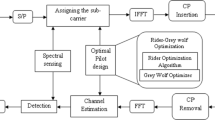Abstract
In the majority of studies on wireless networks, it is assumed that the receiver perfectly knows the channel. Since this is not the case for real life applications, the channel must be estimated in those systems. Thus, current cellular wireless communication systems are designed to perform coherent detection, and channel estimator is one of the most important part of a receiver. The channel estimation error must be minimized, because the error to be made during the channel estimation phase significantly affects the performance of the data detector. This can be made possible by allocating required amount of power to the pilot symbols to estimate channel with minimum error as possible as. Hence, this study examines how to allocate the power between pilot and data symbols to minimize the error of the data detector. The long term evolution provides an opportunity to change the radiation emitted in the pilot sub-carriers according to the data sub-carriers. Since this opportunity is expected to be the case for next generation cellular wireless networks, in this study, the effect of channel estimation error on data detection performance of a multi-user and multi-carrier cellular wireless communication system is investigated. The proposed solution is a practical one to approximate to the optimum solution of the resulting optimization problem without solving it. It is seen that the results obtained in computer simulations are very close to the optimum ones.




Similar content being viewed by others
References
Zhao, N., Yu, F. R., & Sun, H. (2015). Adaptive energy-efficient power allocation in Green interference-alignment-based wireless networks. IEEE Transactions on Vehicular Technology, 64(9), 4268–4281.
Zhao, N., Yu, F. R., Sun, H., & Li, M. (2016). Adaptive power allocation schemes for spectrum sharing in interference-alignment-based cognitive radio networks. IEEE Transactions on Vehicular Technology, 65(5), 3700–3714.
Kibria, M. G., & Shan, L. (2015). Resource allocation optimization for users with different levels of service in multicarrier systems. IEEE Signal Processing Letters, 22(11), 1869–1873.
Zarakovitis, C. C., & Ni, Q. (2016). Maximizing energy efficiency in multiuser multicarrier broadband wireless systems: Convex relaxation and global optimization techniques. IEEE Transactions on Vehicular Technology, 65(7), 5275–5286.
Al-Imari, M., Imran, M. A., & Xiao, P. (2017). Radio resource allocation for multicarrier low-density-spreading multiple access. IEEE Transactions on Vehicular Technology, 66(3), 2382–2393.
Shi, J., Song, Z., & Ni, Q. (2017). Distributed resource allocation assisted by intercell interference mitigation in downlink multicell MC DS-CDMA systems. IEEE Transactions on Wireless Communications, 16(2), 1250–1266.
Hassibi, B., & Hochwald, B. M. (2003). How much training is needed in multiple-antenna wireless links? IEEE Transactions on Information Theory, 49(4), 951–963.
Wu, M., & Kam, P. Y. (2010). Instantaneous symbol error outage probability over fading channels with imperfect channel state information. In 2010 IEEE 71st vehicular technology conference, Taipei (pp. 1–5).
Ghanavati, A. Z., Pareek, U., Muhaidat, S., & Lee, D. (2010). On the performance of imperfect channel estimation for vehicular ad-hoc networks. In 2010 IEEE 72nd vehicular technology conference-fall (pp. 1–5). ON: Ottawa.
Ghanavati, A. Z., & Lee, D. C. (2013). On the performance of selective decode and forward relaying over imperfectly known fading relay channels. In The ninth international conference on wireless and mobile communications, ICWMC 2013 (pp. 173–178).
Ghanavati, A. Z., & Lee, D. C. (2014). Optimal energy allocation between pilot and data symbols for minimizing frame error probability under imperfect fading channel information. In 2014 IEEE wireless communications and networking conference (wcnc), Istanbul (pp. 1990–1995).
Imko, M., Wang, Q., & Rupp, M. (2012). Optimal pilot symbol power allocation under time-variant channels. EURASIP Journal on Wireless Communications and Networking, 2012, 225. https://doi.org/10.1186/1687-1499-2012-225.
Kammoun, Abla, & Abed-Meraim, Karim. (2013). Performance analysis and optimal power allocation for linear receivers based on superimposed training. EURASIP Journal on Wireless Communications and Networking, 2013, 227. https://doi.org/10.1186/1687-1499-2013-227.
He, J., Tang, Z., & Che, Z. (2016). Fast and efficient user pairing and power allocation algorithm for non-orthogonal multiple access in cellular networks. Electronics Letters, 52, 2065–2067.
He, J., & Tang, Z. (2017). Low-complexity user pairing and power allocation algorithm for 5G cellular network non-orthogonal multiple access. Electronics Letters, 53, 626–627.
Salzer, T., Mottier, D., & Brunel, L. (2001). Influence of system load on channel estimation in MC-CDMA mobile radio communication systems. In IEEE VTS 53rd vehicular technology conference, (Vol. 1, pp. 521–526).
Boyd, S., & Vanderberghe, L. (2003). Convex optimization. Cambridge, UK: Cambridge University Press.
Hindi, H. (2004). A tutorial on convex optimization. In Proceedings of 2004 American control conference, Boston, MA, June 30–July 2 (pp. 3252–3265).
Author information
Authors and Affiliations
Corresponding author
Ethics declarations
Conflict of interest
The author, Nihat Kabaoğlu, declares that there is no competing interests regarding the publication of this paper.
Appendix
Appendix
The Lagrangian function of (14) can be obtained as seen in (17) with Karush–Kuhn–Tucker conditions [17, 18], from (18a) to (18j):
Since the aim of this study is to present a practical solution, the optimal solution of the problem is not given here. However, it is too hard, but possible to find the optimum solution \(P_{trn}^{opt}\) of the problem by using the Karush–Kuhn–Tucker conditions given above.
Rights and permissions
About this article
Cite this article
Kabaoğlu, N. A practical power allocation method for multi-user and multi-carrier networks. Wireless Netw 25, 2997–3003 (2019). https://doi.org/10.1007/s11276-018-1695-2
Published:
Issue Date:
DOI: https://doi.org/10.1007/s11276-018-1695-2




